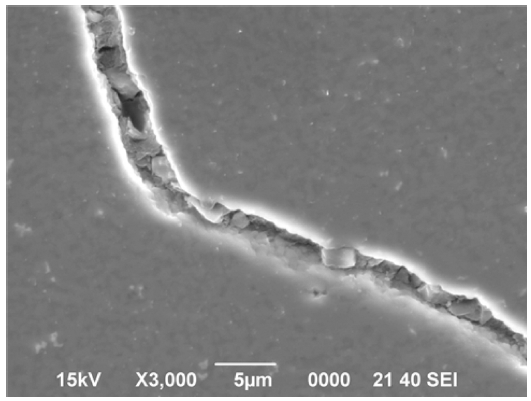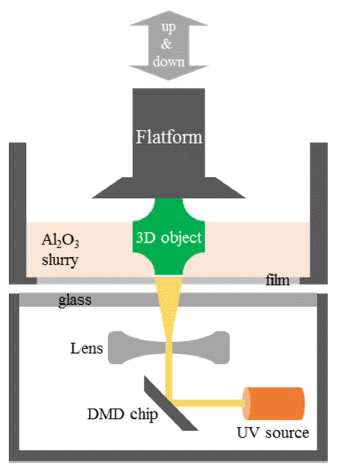Search
- Page Path
- HOME > Search
- [Korean]
- A Study on the Debinding Process of High Purity Alumina Ceramic Fabricated by DLP 3D Printing
- Hyun-Been Lee, Hye-Ji Lee, Kyung-Ho Kim, Sung-Soo Ryu, Yoonsoo Han
- J Korean Powder Metall Inst. 2020;27(6):490-497. Published online December 1, 2020
- DOI: https://doi.org/10.4150/KPMI.2020.27.6.490

- 1,079 View
- 9 Download
- 1 Citations
-
 Abstract
Abstract
 PDF
PDF The 3D printing process provides a higher degree of freedom when designing ceramic parts than the conventional press forming process. However, the generation and growth of the microcracks induced during heat treatment is thought to be due to the occurrence of local tensile stress caused by the thermal decomposition of the binder inside the green body. In this study, an alumina columnar specimen, which is a representative ceramic material, is fabricated using the digital light process (DLP) 3D printing method. DTG analysis is performed to investigate the cause of the occurrence of microcracks by analyzing the debinding process in which microcracks are mainly generated. HDDA of epoxy acrylates, which is the main binder, rapidly debinded in the range of 200 to 500°C, and microcracks are observed because of real-time microscopic image observation. For mitigating the rapid debinding process of HDDA, other types of acrylates PETA, PUA, and MMA are added, and the effect of these additives on the debinding rate is investigated. By analyzing the DTG in the 25 to 300°C region, it is confirmed that the PETA monomer and the PUA monomer can suppress the rapid decomposition rate of HDDA in this temperature range.
-
Citations
Citations to this article as recorded by- Fabrication and Optimization of Al2O3 Microchannels Using DLP-Based 3D Printing
Jun-Min Cho, Yong-Jun Seo, Yoon-Soo Han
Journal of Powder Materials.2025; 32(1): 59. CrossRef
- Fabrication and Optimization of Al2O3 Microchannels Using DLP-Based 3D Printing
- [Korean]
- A Study on the Mechanical Properties of Al2O3 Cutting Tools by DLP-based 3D Printing
- Hyun-Been Lee, Hye-Ji Lee, Kyung-Ho Kim, Kyung-Min Kim, Sung-Soo Ryu, Yoonsoo Han
- J Korean Powder Metall Inst. 2019;26(6):508-514. Published online December 1, 2019
- DOI: https://doi.org/10.4150/KPMI.2019.26.6.508

- 805 View
- 5 Download
- 2 Citations
-
 Abstract
Abstract
 PDF
PDF In the development of advanced ceramic tools, material improvements and design freedom are critical in improving tool performance. However, in the die press molding method, many factors limit tool design and make it difficult to develop innovative advanced tools. Ceramic 3D printing facilitates the production of prototype samples for advanced tool development and the creation of complex tooling products. Furthermore, it is possible to respond to mass production requirements by reflecting the needs of the tool industry, which can be characterized by small quantities of various products. However, many problems remain in ensuring the reliability of ceramic tools for industrial use. In this study, alumina inserts, a representative ceramic tool, was manufactured using the digital light process (DLP), a 3D printing method. Alumina inserts prepared by 3D printing are pressurelessly sintered under the same conditions as coupon-type specimens prepared by press molding. After sintering, a hot isostatic pressing (HIP) treatment is performed to investigate the effects of relative density and microstructure changes on hardness and fracture toughness. Alumina inserts prepared by 3D printing show lower relative densities than coupon specimens prepared by powder molding but indicate similar hardness and higher fracture toughness values.
-
Citations
Citations to this article as recorded by- A Study on Fabrication of PCD Endmill Holder using PBF Additive Manufacturing Technology
Min-Woo Sa, Ho-Min Son, Kyung-Hwan Park, Sang-Geun Lee, Dae-Ho Shin, Dong-Gyu Kim
Journal of the Korean Society of Manufacturing Process Engineers.2024; 23(6): 124. CrossRef - Vat photopolymerization-based 3D printing of complex-shaped and high-performance Al2O3 ceramic tool with chip-breaking grooves: Cutting performance and wear mechanism
Haidong Wu, Wei Liu, Yuerui Xu, Lifu Lin, Yehua Li, Shanghua Wu
Journal of Asian Ceramic Societies.2023; 11(1): 159. CrossRef
- A Study on Fabrication of PCD Endmill Holder using PBF Additive Manufacturing Technology
TOP
 KPMI
KPMI


 First
First Prev
Prev


